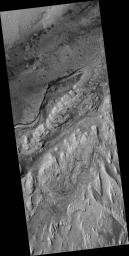Gale Crater is one of several craters around the equator that have deposits of light-toned layered deposits. This HiRISE image covers the northern edge of the light-toned layered deposit in the center mound of Gale Crater, as well as a small portion of the crater floor.
The top of the image shows a relatively flat surface with lots of impact craters. Moving southward, there is a large canyon where dark sands have accumulated and formed ripples and dunes.
As one moves further to the south, the light-toned layered deposit rises upward in topography. Layering can be seen in some locations. The surface of the light-toned deposit is very fractured, producing meter-size blocks. The fact that we don't see many loose rocks along the surface suggests that the rocks are quickly being destroyed by winds due to their fragile nature.
Resistant hills tend to be elongated from the upper left to the lower right, consistent with upslope or downslope winds eroding the rocks.
Observation Geometry
Image PSP_001488_1750 was taken by the High Resolution Imaging Science Experiment (HiRISE) camera onboard the Mars Reconnaissance Orbiter spacecraft on 20-Nov-2006. The complete image is centered at -4.8 degrees latitude, 137.3 degrees East longitude. The range to the target site was 266.9 km (166.8 miles). At this distance the image scale is 26.7 cm/pixel (with 1 x 1 binning) so objects ~80 cm across are resolved. The image shown here has been map-projected to 25 cm/pixel and north is up. The image was taken at a local Mars time of 03:31 PM and the scene is illuminated from the west with a solar incidence angle of 57 degrees, thus the sun was about 33 degrees above the horizon. At a solar longitude of 138.2 degrees, the season on Mars is Northern Summer.
NASA's Jet Propulsion Laboratory, a division of the California Institute of Technology in Pasadena, manages the Mars Reconnaissance Orbiter for NASA's Science Mission Directorate, Washington. Lockheed Martin Space Systems, Denver, is the prime contractor for the project and built the spacecraft. The High Resolution Imaging Science Experiment is operated by the University of Arizona, Tucson, and the instrument was built by Ball Aerospace and Technology Corp., Boulder, Colo.

 Planetary Data System
Planetary Data System












